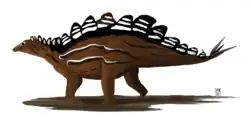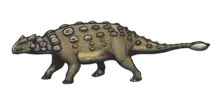Acanthopholis
Acanthopholis (/ˌækənˈθɒfoʊlɪs/; meaning "spiny scales") is a genus of ankylosaurian dinosaur in the family Nodosauridae that lived during the Late Cretaceous Period of England. A single species, A. horrida, exists.[1]
| Acanthopholis | |
|---|---|
 | |
| Artist's rendering of Acanthopholis | |
| Scientific classification | |
| Kingdom: | Animalia |
| Phylum: | Chordata |
| Clade: | Dinosauria |
| Order: | †Ornithischia |
| Family: | †Nodosauridae |
| Subfamily: | †Acanthopholinae Nopcsa, 1923 |
| Genus: | †Acanthopholis Huxley, 1867 |
| Species: | †A. horrida |
| Binomial name | |
| †Acanthopholis horrida Huxley, 1867 | |
History

Around 1865 commercial fossil collector John Griffiths found some dinosaurian remains, including osteoderms, at the shoreline near Folkestone in Kent, which he sold to the metallurgist Dr. John Percy. Percy brought them to the attention of Thomas Henry Huxley, who paid Griffiths to dig up all fossils he could find at the site. Despite being hampered by the fact that it was located between the tidemarks, he managed to uncover several additional bones and parts of the body armour.
In 1867 Huxley named the genus and species Acanthopholis horridus.[1] The dinosaur's generic name refers to its armour, being derived from Greek άκανθα akantha meaning 'spine' or 'thorn' and φόλις pholis meaning 'scale'. The specific name horridus means 'frightening' or 'rough' in Latin. Arthur Smith Woodward emended the species name to Acanthopholis horrida in 1890 because pholis is feminine.[2]
The type specimens, cotypes GSM 109045-GSM 109058, were found in the Chalk Group,[3] a formation itself dating to the Albian to Cenomanian stages around 100 million years ago. The specimens consist of three teeth, a basicranium, a dorsal vertebra, spikes and scutes.
In 1869 Harry Govier Seeley informally named several new species of the genus based on remains from the Cambridge Greensand: "Acanthopholis macrocercus", based on specimens CAMSM B55570-55609; "Acanthopholis platypus" (CAMSM B55454-55461); and "Acanthopholis stereocercus" (CAMSM B55558-55569).[4] Seeley (1871) formally described Acanthopholis platypus as a new species, and in his 1876 description of the sauropod Macrurosaurus semnus he considered the metatarsals included in the A. platypus type material to be possibly conspecific with Macrurosaurus.[5][6] Later, Seeley split the material of Acanthopholis stereocercus and based a new species of Anoplosaurus on part of it: Anoplosaurus major. He also described a new species, Acanthopholis eucercus, on the basis of six caudal vertebrae (CAMSM 55552-55557).[7] In 1902 however Franz Nopcsa changed it into another species of Acanthopholis: Acanthopholis major. Nopcsa at the same time renamed Anoplosaurus curtonotus into Acanthopholis curtonotus. In 1879 Seeley named the genus Syngonosaurus based on part of the type material of "A. macrocercus". In 1956 Friedrich von Huene renamed A. platypus into Macrurosaurus platypus.[8]
In 1999 Xabier Pereda-Superbiola and Paul M. Barrett reviewed all Acanthopholis material. They concluded that all species were nomina dubia whose syntype specimens were composites of non-diagnostic ankylosaur and ornithopod remains. For example, the metatarsals included in the syntype series of Acanthopholis platypus are from a sauropod, but the remaining syntypes are not. They also found two previously unpublished names which Seeley had used to label museum specimens: "Acanthopholis hughesii" indicated SMC B55463-55490 and "Acanthopholis keepingi" SMC B55491-55526. Both names were not proposed by them as new species and are nomina nuda.[9]
Syngonosaurus was synonymised with Acanthopholis in 1999, but the genus was reinstated in a 2020 study, when Syngonosaurus and Eucercosaurus were reinterpreted as basal iguanodontians.[10]
Description
The armour of Acanthopholis consisted of oval keeled plates set almost horizontally into the skin, with long spikes protruding from the neck and shoulder area, along the spine. Acanthopholis was quadrupedal and herbivorous. Its size has been estimated to be in the range of 3 to 5.5 meters (10 to 18 ft) long and approximately 380 kilograms (840 lb) in weight.
Classification
Acanthopholis was originally assigned to the Scelidosauridae by Huxley.[1] In 1902 Nopcsa created a separate family Acanthopholididae.[11] Later, he named Acanthopholinae as a subfamily. In 1928, he corrected Acanthopholididae to Acanthopholidae.[12] Today Acanthopholis is considered a member of the Nodosauridae within the Ankylosauria.
See also
References
- Huxley, T.H. (1867). "IV.—On Acanthopholis Horridus , a New Reptile from the Chalk-marl". Geological Magazine. 4 (32): 65–67. doi:10.1017/S001675680017102X. ISSN 0016-7568.
- Woodward, A.S.; Sherborn, C.D. (1890). A Catalogue of British Fossil Vertebrata. Dulau & Company. p. 209.
- Ethbridge, R. (1867). "V.—On the Stratigraphical Position of Acanthopholis Horridus (Huxley)". Geological Magazine. 4 (32): 67–69. doi:10.1017/S0016756800171031. ISSN 0016-7568.
- Seeley, H.G. (1869). Index to the Fossil Remains of Aves, Ornithosauria, and Reptilia from the Secondary Strata arranged in the Woodwardian Museum of the University of Cambridge. Deighton, Bell and Company. pp. xvii.
- Seeley, H.G. (1871). "XXXVII.— On Acanthopholis platypus (Seeley), a Pachypod from the Cambridge Upper Greensand". Annals and Magazine of Natural History. 8 (47): 305–318. doi:10.1080/00222937108696494. ISSN 0374-5481.
- H.G. Seeley, 1876, "On Macrurosaurus semnus (Seeley), a long tailed animal with procoelous vertebrae from the Cambridge Upper Greensand, preserved in the Woodwardian Museum of the University of Cambridge", Quarterly Journal of the Geological Society of London 32: 440-444 doi:10.1144/GSL.JGS.1876.032.01-04.50
- Seeley, H.G. (1879). "On the Dinosauria of the Cambridge Greensand". Quarterly Journal of the Geological Society. 35 (1–4): 591–636. doi:10.1144/GSL.JGS.1879.035.01-04.42. ISSN 0370-291X. S2CID 129277596.
- von Huene, F. (1956) "Palaeontologie und Phylogenie der niederen Tetrapoden"
- Superbiola, X.P.; Barrett, P.M. (1999). "A systematic review of ankylosaurian dinosaur remains from the Albian-Cenomanian of England". Special Papers in Palaeontology. 60: 177–208.
- Barrett, Paul M.; Bonsor, Joseph A. (2020). "A revision of the non-avian dinosaurs Eucercosaurus tanyspondylus and Syngonosaurus macrocercus from the Cambridge Greensand, UK". Cretaceous Research: 104638. doi:10.1016/j.cretres.2020.104638.
- B. F. Nopcsa. 1902. Notizen über cretacische Dinosaurier [Notes on Cretaceous dinosaurs]. Sitzungsberichte der Mathematisch-Naturwissenschaftlichen Classe der Kaiserlichen Akademie der Wissenschaften 111(1):93-114
- B. F. Nopcsa. 1928. The genera of reptiles. Palaeobiologica 1:163-188 [M. Carrano/M. Carrano/M. Carrano]
References
- Carpenter, Kenneth (2001). "Phylogenetic Analysis of Ankylosauria". In Carpenter, Kenneth (ed.). The Armored Dinosaurs. Indiana University Press. pp. 455–480. ISBN 0-253-33964-2.

